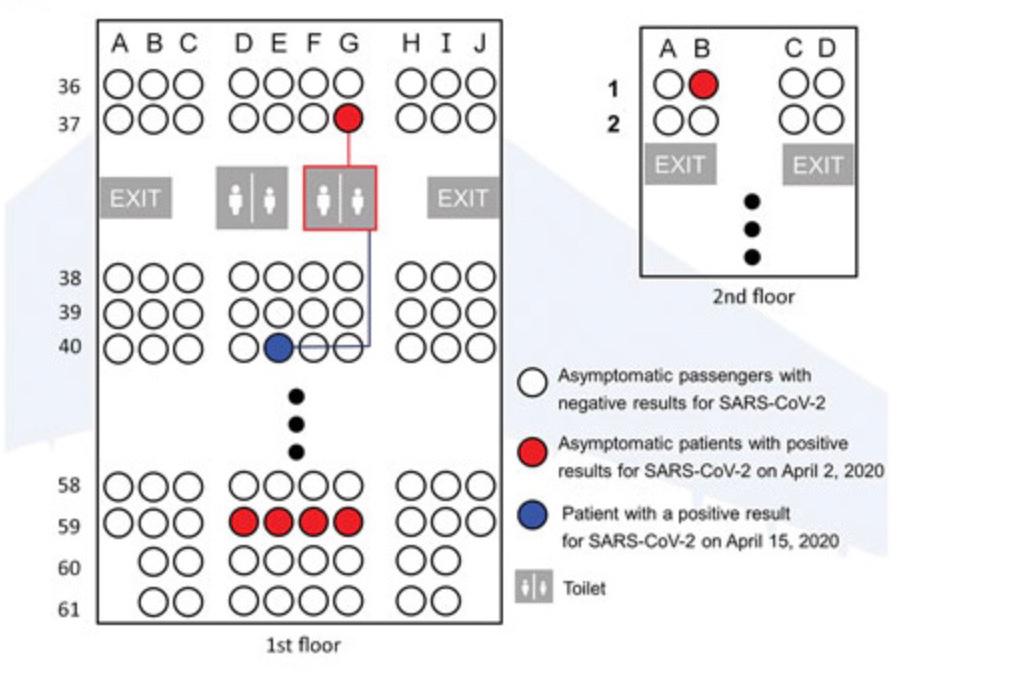
A study funded by the government of South Korea suggests that a passenger who is infected with the novel coronavirus that causes COVID-19 but shows no symptoms can infect other passengers on the same flight.
The study of asymptomatic transmission of the SARS-CoV-2 virus recommends that “further attention is warranted” to reduce the spread of the disease on aircraft, and reiterates the basics of prevention: mask-wearing, hand hygiene and maintaining physical distance between passengers before they board and after they disembark the aircraft.
Based on wider studies and flight data, known cases of inflight transmission of COVID-19 remain rare, with much of the analysis done before airlines introduced mask requirements for passengers.
The recommendations of the South Korean study surfaced at a time when the U.S. Centers for Disease Control and Prevention (CDC), in the course of a week, released and then attempted to clarify controversial guidance suggesting that individuals who come within 6 ft. of an infected person for at least 15 min., but are asymptomatic, “do not necessarily need a test” for COVID-19. Nevertheless, the CDC estimates that 40% of infected people are asymptomatic.
Lacking a federal mandate, U.S. airlines are hard-pressed to enforce mask-wearing policies. In an internal memo dated Aug. 27, Delta Air Lines CEO Ed Bastian informed employees that 240 people have been placed on a Delta no-fly list for refusing to wear face masks.
Not a final product, the South Korean study of asymptomatic transmission was published as a summary, early-release article on the CDC website; the final article will be published in an upcoming issue of the agency’s Emerging Infectious Diseases journal.
While inflight transmission of SARS-CoV-2 by symptomatic passengers has been established, the authors say—citing studies that identified fever as a common indicator of infection—transmission by asymptomatic passengers is inconclusive.
Researchers conducted a cohort study of 310 passengers who boarded an evacuation flight from Milan Malpensa Airport (MXP), Italy to Incheon Airport, South Korea on March 31. The Seoul government had chartered the flight “to avoid infections in [that] virus-hit country,” South Korea’s Yonhap News Agency reported at the time. Responding to an inquiry, one of the study’s authors said the aircraft was a Boeing 747-8I.
Korea Centers for Disease Control and Prevention (KCDC) medical personnel conducted physical examinations, interviews and temperature checks outside the airport when passengers arrived at MXP, and 11 symptomatic people were removed from the flight. Those passengers who continued were issued N95 respirator masks and kept 2m (6.5 ft.) apart from each other during pre-boarding. “Most passengers wore the N95 respirators except at mealtimes and when using the toilet during the flight,” the researchers said.
Following an 11-hour flight, 299 asymptomatic passengers arrived in South Korea and were immediately quarantined and kept away from each other for two weeks at a government facility. Medical staff examined the passengers twice daily for elevated body temperature and symptoms of COVID-19. All were tested for SARS-CoV-2 on Days 1 and 14 of the quarantine by the technique called reverse transcription polymerase chain reaction, which requires a nose or throat swab.
Six of the passengers tested positive for the virus on Day 1 and were immediately transferred to a hospital. On Day 14, a 28-year-old woman tested positive. She reported wearing an N95 mask during the flight except when she used the toilet, which was shared by the passengers sitting near her. One of those passengers was an asymptomatic infected person seated three rows forward of the woman (the lavatory itself separated the two passengers, as well).
“Given that she did not go outside and had self-quarantined for three weeks alone at her home in Italy before the flight and did not use public transportation to get to the airport, it is highly likely that her infection was transmitted in the flight via indirect contact with an asymptomatic patient,” the researchers say. “[T]he most plausible explanation for the transmission of SARS-CoV-2 to a passenger on the aircraft is that she became infected by an asymptomatic but infected passenger while using an onboard toilet.”
Apparently answering another researcher’s question in an email response to Aviation Daily, the study author said: “I agree with your opinion of the possibility of transmission of SARS-CoV-2 by toilet plumes containing aerosolized viruses.”
Based on their findings from the study, the researchers say that contact with contaminated surfaces increases the risk of transmitting the virus among passengers, and that hand hygiene is necessary to prevent infections. Facial masks should be worn during a flight and physical distancing maintained before boarding and after disembarking from the aircraft.





